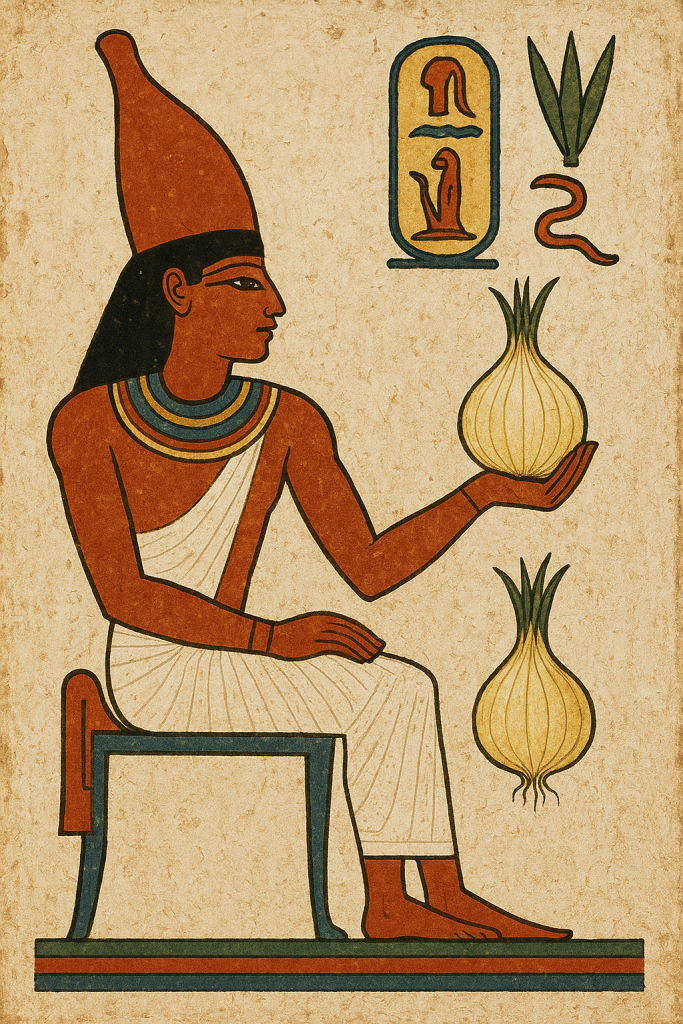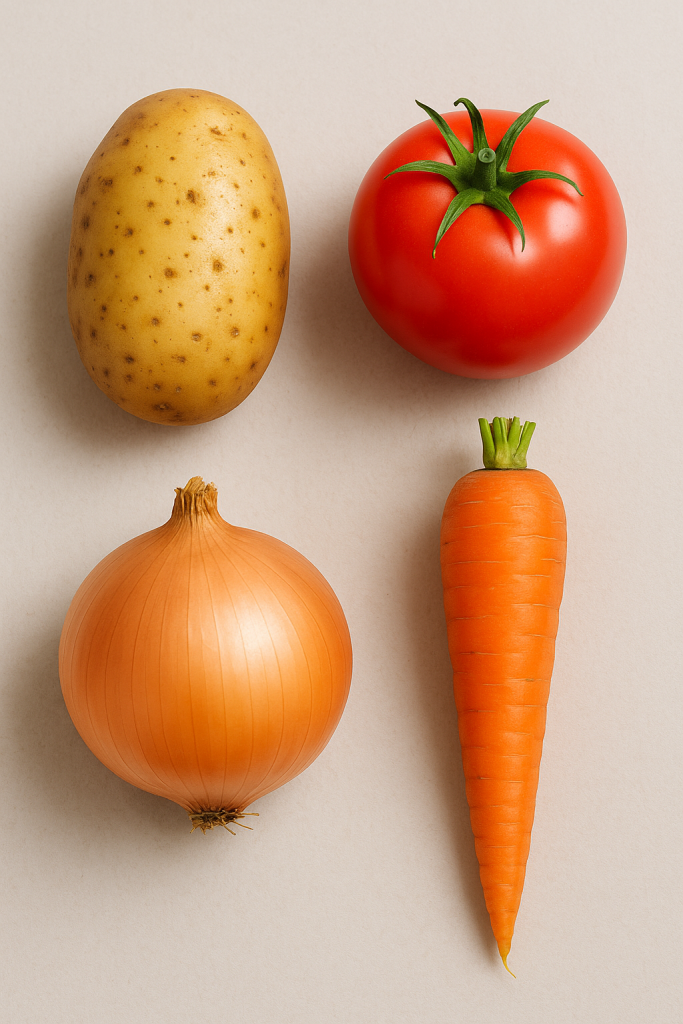⏲️ Estimated reading time: 6 min
🌍 The Surprising Origins of the World’s Most Consumed Vegetables: Potato, Tomato, Onion, and Carrot
Potatoes, tomatoes, onions, and carrots dominate global diets, but their origins remain surprising. From ancient empires to modern kitchens, these vegetables traveled continents, faced rejection and acceptance, and transformed cultures. Discover the fascinating story behind the world’s most eaten vegetables.
Why These Vegetables Changed the World
When we look at our plates today, potatoes, tomatoes, onions, and carrots seem ordinary, even inevitable. They are the foundation of countless recipes worldwide, from mashed potatoes and soups to sauces and stir-fries. But behind their familiarity lies an extraordinary history.
Each of these vegetables traveled thousands of miles and thousands of years to become what they are today. Their origins reveal how deeply human history is connected to food, trade, and cultural exchange. Without them, the world’s cuisines would look completely different.
In this article, we’ll explore the origins, domestication, cultural significance, and nutritional value of these four vegetables that shaped the modern diet.
🥔 The Potato – The Hidden Treasure of the Andes
Ancient Origins
The potato (Solanum tuberosum) is native to the Andes Mountains of South America, particularly in what is now Peru and Bolivia. Archaeological evidence shows that potatoes were first domesticated more than 7,000 years ago, making them one of the oldest cultivated crops.
Wild potatoes contained solanine, a toxic compound. Indigenous peoples ingeniously developed preparation methods to make them safe, such as freeze-drying and sun-drying to create chuño, a dehydrated potato that could be stored for years.
Journey to Europe
Spanish conquistadors brought the potato to Europe in the 16th century after conquering the Inca Empire. Initially, Europeans were suspicious of it. Potatoes were considered either ornamental plants or even poisonous.
In France, agronomist Antoine-Augustin Parmentier played a key role in popularizing the potato by hosting dinners where he served potato-based dishes to nobles and even royalty.
Role in History
By the 18th and 19th centuries, the potato had become a dietary staple across Europe due to its high yield, resilience, and nutritional value. However, dependence on potatoes had tragic consequences during the Irish Potato Famine (1845–1849), when a fungal blight wiped out crops, causing massive starvation and emigration.
Nutritional Value and Global Impact
Today, the potato is the fourth most important food crop in the world, after rice, wheat, and corn. It provides complex carbohydrates, fiber, vitamin C, potassium, and iron.
Potatoes fueled population growth in Europe, Asia, and Africa and remain a cornerstone of global food security.

🍅 The Tomato – A Fruit That Became a Universal Vegetable
Origins in the Americas
The tomato (Solanum lycopersicum) is native to Central and South America, especially Mexico and Peru. The Aztecs cultivated it and called it xītomatl, from which the word “tomato” derives.
Suspicion in Europe
When the Spanish introduced tomatoes to Europe in the 16th century, they were regarded with suspicion. As part of the nightshade family (Solanaceae), tomatoes were believed to be poisonous.
For centuries, tomatoes were grown mainly as ornamental plants. In Italy, by the 17th century, they began to appear in cooking, transforming Mediterranean cuisine forever.
Culinary Revolution
Once accepted, the tomato became indispensable. Imagine Italy without pasta sauce or pizza, Spain without gazpacho, or Mexico without salsa. Tomatoes reshaped entire culinary traditions.
Nutritional Benefits
Tomatoes are rich in lycopene, a powerful antioxidant associated with reduced risks of heart disease and cancer. They also provide vitamin C, potassium, folate, and fiber.
Global Influence
Today, tomatoes are among the most widely grown crops worldwide. They are central to the global food industry, appearing in sauces, ketchup, canned goods, and fresh salads.

🧅 The Onion – The Sacred Vegetable of Ancient Civilizations
Ancient Roots
The onion (Allium cepa) is believed to have originated in Central Asia or the Middle East. It is one of the oldest vegetables cultivated by humans, with evidence dating back more than 5,000 years.
Onion in Ancient Egypt

In Ancient Egypt, people considered onions sacred because their concentric layers symbolized eternity. They used onions as food, medicine, and offerings to the gods. Archaeologists even discovered onions in the tomb of Pharaoh Tutankhamun.
Spread Through Empires
The Greeks and Romans adopted onions, praising their medicinal properties. Roman soldiers ate onions to gain strength and endurance, spreading their cultivation across Europe.
Nutritional and Medicinal Value
Onions contain antioxidants, vitamin C, and sulfur compounds that have antibacterial, anti-inflammatory, and cardiovascular benefits.
Global Role in Cuisine
From French onion soup to Indian curries, Mexican salsas, and Chinese stir-fries, onions are truly a universal base ingredient. They provide depth of flavor in nearly every cuisine worldwide.

🥕 The Carrot – From Purple Roots to Orange Icons
Early Origins
The carrot (Daucus carota) originated in Central Asia, especially modern-day Afghanistan and Iran. Early carrots were purple, red, or yellow, and had a bitter taste compared to today’s sweet varieties.
Birth of the Orange Carrot
The now-familiar orange carrot was developed in the Netherlands during the 17th century through selective breeding. According to legend, Dutch farmers created it in honor of the House of Orange, the royal family.
Global Spread and Popularity
Carrots spread rapidly across Europe and eventually to the rest of the world. Their versatility and nutritional value made them a common staple in soups, stews, salads, and juices.
Nutritional Powerhouse
Carrots are rich in beta-carotene, which the body converts into vitamin A, essential for vision and immune function. They also contain vitamin K, potassium, and fiber.
Symbolism and Modern Use
Carrots became symbols of health and even propaganda. During World War II, British pilots were said to eat carrots to improve their night vision, a clever cover story for the use of radar technology.

🌐 How These Vegetables Transformed Global Cuisine
- Potatoes ended famines and fueled population growth.
- Tomatoes revolutionized Mediterranean and Latin American cooking.
- Onions became the indispensable base of savory dishes.
- Carrots brought color, sweetness, and essential nutrients.
Together, these vegetables shaped modern gastronomy, proving that food is deeply tied to history, culture, and survival.
✨ Fascinating Facts
- Potatoes are used to make vodka in Eastern Europe.
- Tomatoes were once nicknamed “love apples” in France.
- Onions were given to athletes in Ancient Greece as an energy booster.
- Purple carrots are making a comeback as a modern “superfood.”

Final Thoughts
Potatoes, tomatoes, onions, and carrots are far more than everyday vegetables. They are living artifacts of human history, representing survival, adaptation, and cultural evolution. Without them, not only would our plates look different, but the course of world history itself would have changed.
🔔 For more tutorials like this, consider subscribing to our blog.
📩 Do you have questions or suggestions? Leave a comment or contact us!
🏷️ Tags: potato history, tomato origin, onion ancient use, carrot evolution, world vegetables, nutrition, food culture, agriculture history, global cuisine, vegetable traditions
📢 Hashtags: #potato #tomato #onion #carrot #vegetables #history #nutrition #cuisine #origins #foodculture
Only logged-in users can submit reports.
Discover more from HelpZone
Subscribe to get the latest posts sent to your email.

